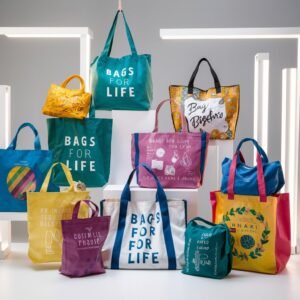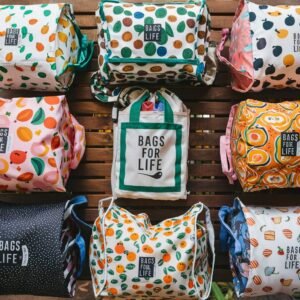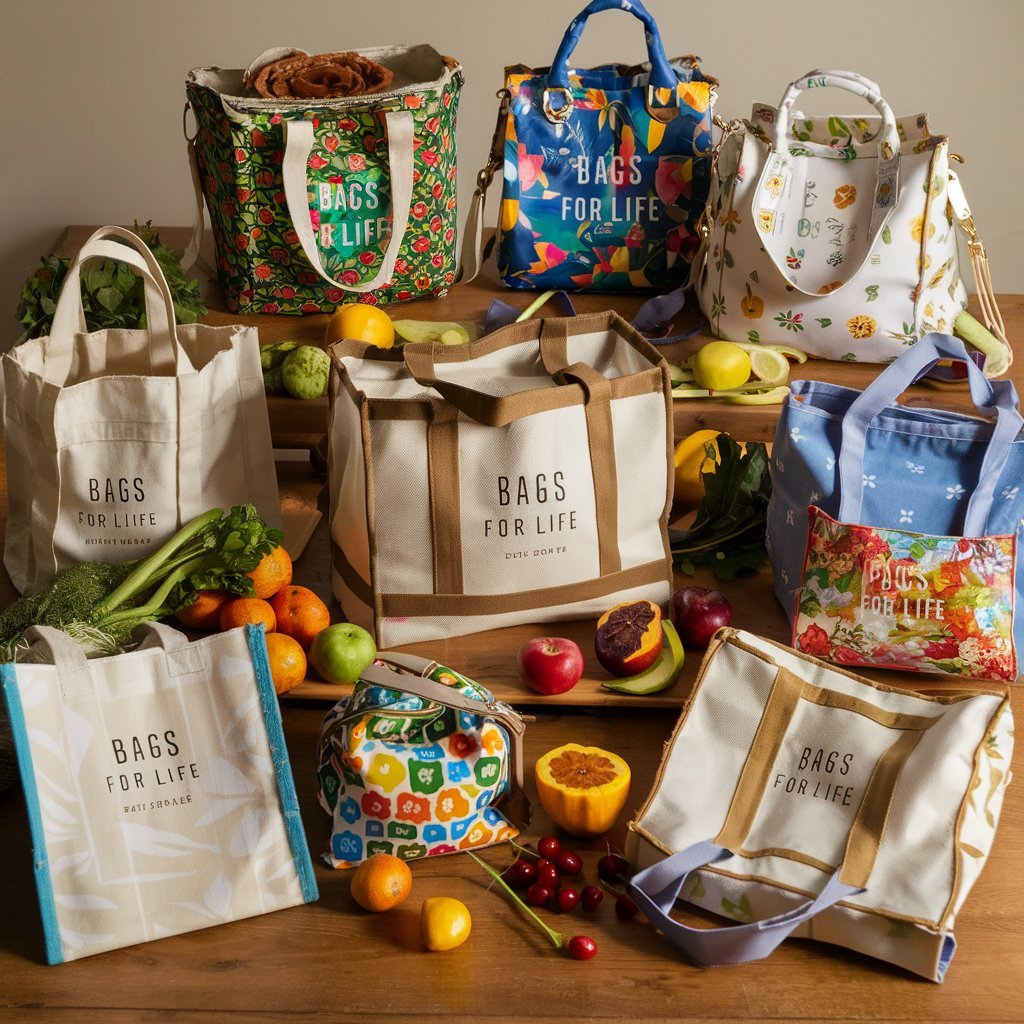In a world increasingly aware of environmental issues, the concept of “bags for life” has gained significant traction. These durable, reusable bags are designed to replace single-use plastic bags, thereby reducing waste and promoting sustainability. This article delves into what makes bags for life an effective eco-friendly choice, showcasing various examples that highlight their versatility and benefits.
What Are Bags for Life?
Bags for life are reusable bags made from strong, durable materials. Unlike single-use plastic bags, which often end up in landfills or oceans, bags for life can be used repeatedly over many years. Their robustness means they can carry heavier loads and withstand more wear and tear than traditional plastic bags.
These bags are intended to replace single-use plastic bags and promote sustainability by encouraging reusable alternatives. Here are some characteristics of a good bag for life:
- Durability: A bag for life should be made from sturdy and resilient materials that can withstand frequent use and heavy loads. Look for bags constructed from reinforced fabrics such as canvas, nylon, or recycled materials.
- Strength and Capacity: The bag should have a strong and supportive structure with reinforced handles or straps to comfortably carry groceries, books, or other items. Consider the bag’s capacity and size to ensure it can accommodate your needs.

- Reusable and Washable: A bag for life should be reusable and washable to maintain cleanliness and hygiene over time. Choose a bag that is easy to clean and can be machine washed or wiped down with a damp cloth.
- Foldable and Portable: Opt for a bag that is foldable or collapsible for easy storage and portability. Look for bags that can be compactly folded into a pouch or pocket-sized form for convenient carrying in a purse, backpack, or car.
- Environmentally Friendly: Select a bag made from sustainable and eco-friendly materials, such as organic cotton, recycled polyester, or biodegradable plastics. Avoid bags containing harmful chemicals or toxins that may leach into the environment.
- Versatility: Choose a versatile bag that can be used for various purposes beyond shopping, such as carrying gym gear, beach essentials, or picnic supplies. Look for bags with multiple compartments or pockets for added functionality.
- Design and Aesthetics: Consider the design and aesthetics of the bag, including color, pattern, and style, to suit your personal preferences and fashion sense. Choose a bag that reflects your personality and complements your lifestyle.

- Promotional or Customized Options: Many retailers and organizations offer promotional or customized bags for life featuring logos, slogans, or artwork. Consider supporting brands or causes that align with your values and beliefs.
- Cost-Effectiveness: While the initial cost of a bag for life may be higher than that of a single-use plastic bag, consider the long-term cost-effectiveness and environmental benefits of investing in a reusable alternative. Calculate the savings from avoiding disposable bags over time.
- Community Engagement: Get involved in initiatives or campaigns promoting the use of bags for life within your community. Encourage others to adopt sustainable habits and reduce plastic waste by providing information and resources on reusable alternatives.
Examples of Effective Bags for Life
1. Canvas Tote Bags
Description: Canvas tote bags are made from sturdy canvas material, known for its durability and capacity to handle heavy loads. These bags are often equipped with long handles, making them easy to carry on the shoulder.
Usage: Ideal for grocery shopping, carrying books, or as an everyday carry-all. Canvas totes are popular for their versatility and are often customized with unique prints and designs.
Example: A canvas tote from a local grocery store with reinforced seams and a catchy eco-friendly slogan printed on the side. 
2. Jute Bags
Description: Made from natural jute fibers, these bags are both strong and biodegradable. They often feature a rustic, natural appearance and may have laminated interiors for added durability.
Usage: Perfect for carrying groceries, fresh produce, or as beach bags. Jute bags are robust enough to handle weighty items without tearing.
Example: A jute bag from a farmer’s market, with a laminated interior to prevent moisture from damaging the bag.
3. Nylon or Polyester Foldable Bags
Description: These bags are crafted from lightweight yet durable nylon or polyester. They can be folded into a compact pouch, making them highly portable.
Usage: Great for spontaneous shopping trips or as backup bags carried in purses or pockets. Despite their compact size, they can expand to hold a substantial amount of items.
Example: A foldable nylon bag that fits into a small pouch, perfect for travelers who need an extra bag that doesn’t take up space when not in use.
4. Recycled Plastic Bags
Description: Made from recycled plastic bottles or other recycled materials, these bags are durable and often waterproof.
Usage: Suitable for carrying groceries, gym clothes, or everyday items. By repurposing plastic waste, these bags help reduce overall plastic consumption.
Example: A bag made from recycled PET bottles, available at many retail stores, demonstrating a closed-loop approach to plastic use.
5. Hemp Bags
Description: Hemp is a sustainable and eco-friendly material known for its strength and durability. Hemp bags are resistant to mold and ultraviolet light.
Usage: Ideal for grocery shopping, carrying books, or as everyday bags. Their natural texture and durability make them a stylish and practical choice.
Example: A hemp bag with sturdy handles and a natural look, perfect for eco-conscious consumers. 
6. Non-Woven Polypropylene Bags
Description: These bags are made from non-woven polypropylene fabric, which is lightweight and durable. They are often used for promotional purposes.
Usage: Commonly used for groceries, retail shopping, or as promotional giveaways. They are easy to clean and can be reused multiple times.
Example: A non-woven polypropylene bag given out at a trade show, with a company’s logo printed on it, demonstrating its use as both a practical item and a marketing tool.
7. Insulated Cooler Bags
Description: These bags have an insulated lining designed to keep items cold or hot, making them perfect for transporting groceries, especially perishables.
Usage: Ideal for picnics, grocery shopping, or transporting meals. Their insulation helps maintain the temperature of food and beverages.
Example: An insulated cooler bag from a grocery store, perfect for keeping dairy products and frozen goods cool on the trip home.
8. Organic Cotton Bags
Description: Made from organic cotton grown without pesticides and synthetic fertilizers, these bags are soft, durable, and biodegradable.
Usage: Suitable for carrying groceries, books, or as stylish everyday bags. They appeal to consumers looking for eco-friendly and sustainable products.
Example: An organic cotton bag with a minimalist design, popular among environmentally conscious shoppers.
Benefits of Using Bags for Life
- Environmental Impact: By reducing the need for single-use plastic bags, bags for life help decrease plastic pollution and its harmful effects on wildlife and ecosystems.
- Cost-Effective: Although the initial cost might be higher, the durability of bags for life means they can be used for many years, saving money in the long run.
- Versatility: Available in various materials and designs, these bags can be used for shopping, traveling, or as everyday carry bags.
- Supporting Sustainability: Many bags for life are made from recycled or sustainable materials, further reducing their environmental footprint.
Bags for life are a practical and sustainable alternative to single-use plastic bags. By investing in these durable, reusable bags, individuals can make a significant positive impact on the environment. With a variety of options available, from canvas totes to insulated cooler bags, there is a bag for every need and preference. Embracing these eco-friendly choices not only helps protect our planet but also promotes a more sustainable lifestyle for future generations.
Choose a durable, reusable, and environmentally friendly bag for life, that helps you to reduce plastic pollution, conserve resources, and promote sustainability for future generations. Make a conscious effort to incorporate reusable bags into your daily routine and inspire others to join the movement towards a cleaner and greener planet.

